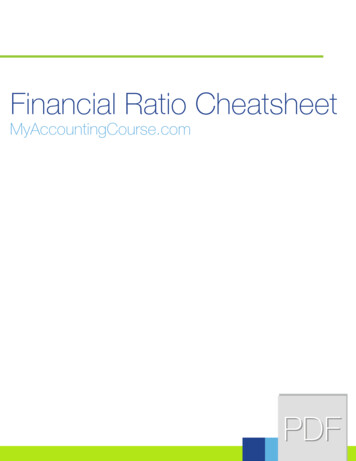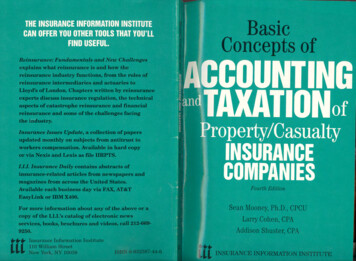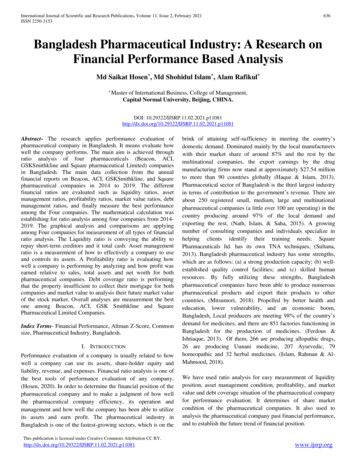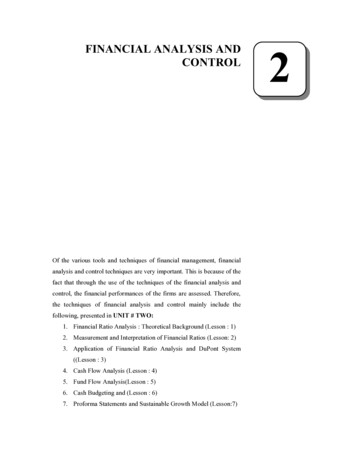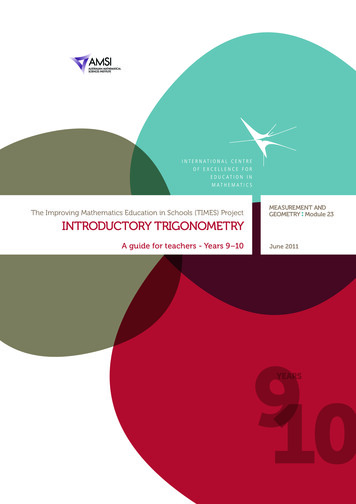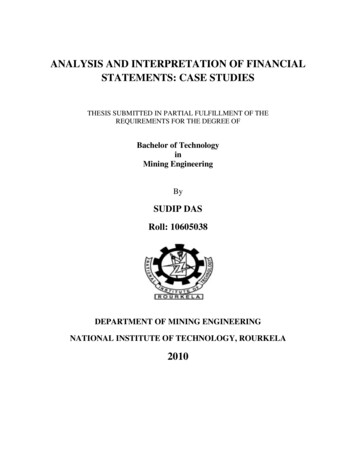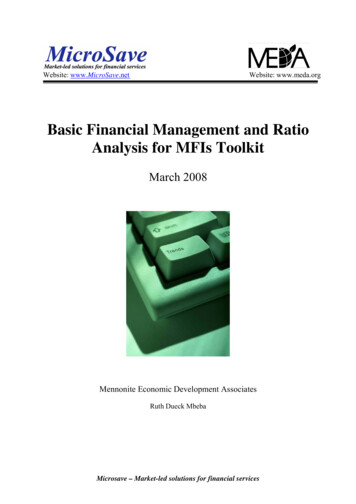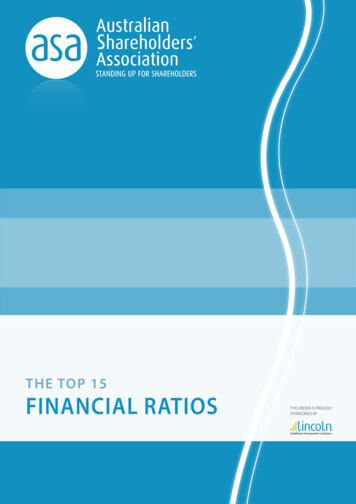
Transcription
The Top 15Financial RatiosThis ebook is proudlysponsored BY
ContentsIntroduction. 3Chapter 1: Background. 4Chapter 2: Why use ratios?. 5Chapter 3: Liquidity ratios. 6Chapter 4: Leverage ratios. 10Chapter 5: Profitability ratios. 14Chapter 6: Valuation ratios. 19About the Author. 22The Top 15 Financial RatiosLincoln Indicators Pty Ltd 2010. All rights reserved.2
IntroductionFor ordinary investors, the task ofdetermining the health of a listedcompany by looking at financialratios may seem daunting. Yet, itdoesn’t require special training orcountless hours of research. Even thenovice investor can make sense of alisted company’s balance sheet, profitand loss and cash flow statement byusing financial ratios.By financial ratios we mean taking afinancial figure and looking at it relativeto another financial figure. These ratiosThe Top 15 Financial Ratiossimplify the process of determining thehealth of a listed company and makereported financial information moremeaningful and useful for investors.In this e-book we cover 15 ratiosthat measure a company’s liquidity,leverage, profitability and share pricevalue. Understanding these ratios willgo a long way to providing you with anidea of how a company is performingin relation to key measures of businesssuccess.3
Chapter 1A background on financial ratio analysisFinancial ratio analysis has been usedto assess company performancefor almost as long as modernsharemarkets have been around.The methods are based on tried-andtrue accounting ratios, which have beenaround for even longer. The theoryof financial ratio analysis was firstpopularised by Benjamin Graham whois considered by many to be the fatherof fundamental analysis. BenjaminGraham, who from 1928 was a professorat Columbia Business School as well as avery successful investor in his own right,was mentor and teacher to WarrenBuffett.“ Fundamental analysisand financial ratioanalysis must form thebasis of all investmentdecisions, because withoutknowing the true financialposition of a company youare purely speculating.”The Top 15 Financial RatiosFundamental analysis, of whichfinancial ratio analysis is but one subset, looks at a company’s financialstatements, management, health andposition in the competitive landscapeto determine a share price valuation. Itis different from the other commonlyused methods of investment analysis– quantitative analysis and technicalanalysis – in that it looks from thebottom-up rather than from the topdown, or – in the case of technicalanalysis – from what the charts say.Financial ratios are tools to help withthe interpretation of results and toallow for comparison to previousyears, other companies and theindustry sector. Fundamental analysisand financial ratio analysis must formthe basis of all investment decisions,because without knowing the truefinancial position of a company you arepurely speculating.Lincoln Indicators Pty Ltd 2010. All rights reserved.4
Chapter 2Why use financial ratios?Fundamental analysis and financialratio analysis, as you can imagine,is a pretty powerful thing and isessential for successful investing.Some people may opt for quantitativeor technical analysis methods whenit comes to sharemarket investing,depending upon their personalities,spare time and inclinations, but formost investors, fundamental analysisoffers a sound, intellectual frameworkfor making informed share investmentdecisions.“ fundamentalanalysis offers a sound,intellectual framework formaking informed shareinvestment decisions.”Within the broad discipline offundamental analysis, financial ratioanalysis in turn offers the clearest,easiest and most logical set of indicatorsfor a sharemarket investor. Empiricaland tested evidence suggests thatfundamental and ratio analysis is apowerful ally in the hands of an activeand savvy investor.The Top 15 Financial RatiosLincoln Indicators Pty Ltd 2010. All rights reserved.5
Chapter 3Liquidity ratiosLiquidity ratios indicate whether acompany has the ability to pay offshort-term debt obligations (debtsdue to be paid within one year) as theyfall due. Generally, a higher value isdesired as this indicates greater capacityto meet debt obligations.1. Current ratioThe Current ratio measures a company’sability to repay short-term liabilitiessuch as accounts payable and currentdebt using short-term assets such ascash, inventory and receivables. Anotherway to look at it would be the value ofa company’s current assets that will beconverted to cash over the next twelvemonths compared to the value ofliabilities that will mature over the sameperiod.Formula:Current ratio Example:Current ratio Current ratio The Current ratio is useful as it showswhether a company has adequateresources to repay short-term debt orif it will experience cash flow problemsin the near term.A ratio of 2:1 is usually considered thebenchmark, however, this may varyacross industries. A ratio of less thanone suggests that the company maynot have sufficient resources to settleits short-term debt obligations if theyfell due today. In the example above,the company is considered sufficientlyliquid as it has 2 worth of assets forevery 1 worth of liability.For a more conservative alternative,the numerator (Current assets) maybe adjusted to remove inventory, asinventory may be viewed as not veryreadily convertible to cash. This isknown as the Quick ratio.Current assetsCurrent liabilities 1,000,000 500,0002The Top 15 Financial RatiosLincoln Indicators Pty Ltd 2010. All rights reserved.6
Chapter 3Liquidity ratios2. Profit before depreciation andamortisation to current liabilities(PDACL)rofit before depreciation andamortisation to current liabilitiesis defined as net operating profitbefore tax plus non-cash charges inrelation to short-term debt obligations.This is a powerful ratio because itdepicts a company’s margin of safetyto meet short-term commitmentsusing cash flow generated from tradingoperations.PLower risk companies exhibit a highermargin of safety, whereas higher riskcompanies exhibit a lower margin ofsafety. Should the company need to callon resources to meet short-term debtobligations, a lower margin of safetymay be an issue.“This is a powerful ratiobecause it depicts acompany’s margin ofsafety to meet short-termcommitments using cashflow generated fromtrading operations.”Formula:Profit before depreciation and amortisationPDACL Current liabilitiesExample: 170,000PDACL 500,000PDACL 0.34The Top 15 Financial RatiosLincoln Indicators Pty Ltd 2010. All rights reserved.7
Chapter 3Liquidity ratios3. Operating cash flow to currentliabilities (OCFCL)perating cash flow to currentliabilities pertains to the cashgenerated from the operationsof a company (revenues less alloperating expenses, plus depreciation),in relation to short-term debtobligations. Operating cash flow is amore accurate measure of a company’sprofitability than net income because itonly deducts actual cash expenses andtherefore demonstrates the strength ofa company’s operations.OConsistently negative operatingcash flow implies a business is goingbackwards in relation to the cost toconduct ordinary operations.Formula:Operating cash flowOCFCL Current liabilitiesA positive operating cash flow is vitalto support ongoing operations. TheOCFCL ratio is significant because itshows the ability of a company tomeet short-term debt obligations frominternally generated cash flow.The higher the value of the OCFCLratio, the lower the level of risk. Ahigh value indicates that the companygenerates sufficient cash from itsoperations to cover short-termliabilities. Conversely, a lower value forOCFCL denotes higher risk.“Consistently negativeoperating cash flowimplies a business is goingbackwards in relationto the cost to conductordinary operations.”Example: 180,000OCFCL 500,000OCFCL 0.36The Top 15 Financial RatiosLincoln Indicators Pty Ltd 2010. All rights reserved.8
Chapter 3Liquidity ratios4. Cash balance to total liabilities(CBTL)his ratio shows a company’s cashbalance in relation to its totalliabilities. Cash is the most liquidasset a business has. A negative cashbalance (caused by overdrafts) raisesa warning signal and failure to addresssuch an issue will likely result in liquidityproblems.TLower risk firms typically have a highervalue CBTL, because they have morecash that can be used to pay suppliers,banks or any other party that hasprovided the company with a product orservice. Higher risk companies typicallyhave a lower value CBTL, which meansthe company’s ability to meet its debtobligations is significantly hampered.“A negative cash balance(caused by overdrafts)raises a warning signaland failure to addresssuch an issue willlikely result in liquidityproblems.”Formula:Cash balanceCBTL Total liabilitiesExample: 280,000CBTL 800,000CBTL 0.35The Top 15 Financial RatiosLincoln Indicators Pty Ltd 2010. All rights reserved.9
Chapter 4Leverage ratiosLeverage ratios, also referred to asgearing ratios, measure the extentto which a company utilises debtto finance growth. Leverage ratios canprovide an indication of a company’slong-term solvency. Whilst mostfinancial experts will acknowledge thatdebt is a cheaper form of financing thanequity, debt carries risks and investorsneed to be aware of the extent of thisrisk.5. Debt to equity ratio (DE ratio)The debt to equity ratio providesan indication of a company’s capitalstructure and whether the companyis more reliant on borrowings (debt)or shareholder capital (equity) to fundassets and activities.Formula:Total debtDE ratio Shareholders’ equityExample: 800,000DE ratio 700,000DE ratio 1.14The Top 15 Financial RatiosContrary to what many believe,debt is not necessarily a bad thing.Debt can be positive, provided it isused for productive purposes suchas purchasing assets and improvingprocesses to increase net profits.Acceptable debt to equity ratios mayalso vary across industries. Generally,companies that are capital intensivetend to have higher ratios because ofthe requirement to invest more heavilyin fixed assets.The DE ratio example shownbelow indicates that for every 1of shareholder ownership in thecompany, the company owes 1.14to creditors. A higher ratio generallyindicates greater risk. Greater debtcan result in volatile earnings due toadditional interest expense as wellas increased vulnerability to businessdownturns.But as with all other ratios, the DEratio will be more meaningful whencompared over a period of time. Forinstance, in the example above, 1.14 ishigh when taken independently but itcould actually be low and consideredgood if the company has historicallymaintained a debt to equity ratio of1.5. Such a change in ratios couldmean that previous investments arestarting to pay off, leading to higherretained earnings and, therefore,higher shareholder equity.Lincoln Indicators Pty Ltd 2010. All rights reserved.10
Chapter 4Leverage ratios6. Total liabilities to total tangibleassets (TLTAI)his ratio provides the relationshipbetween a company’s liabilitiesand tangible assets. Tangibleassets are defined as physical assets,such as property, cash, inventory andreceivables. This classification excludesintangible assets, or those assets thatcannot be physically touched like thevalue of a brand, franchise, patent ortrademark.TThe use of tangible assets, as opposedto total assets, is more conservativebecause it considers only those assetsthat can be easily valued and, therefore,easily liquidated to cover liabilities.The higher the value of the TLTAI ratio,the higher the level of risk. In this case,the company is exposed to a high levelof risk because it has 1.60 in liabilitiesfor every 1 in tangible assets.“The higher the value of theTLTAI ratio, the higher thelevel of risk.”Formula:Total liabilitiesTLTAI Total tangible assetsExample: 800,000TLTAI 500,000TLTAI 1.60The Top 15 Financial RatiosLincoln Indicators Pty Ltd 2010. All rights reserved.11
Chapter 4Leverage ratiosA7. Interest cover ratiocompany’s interest cover ratiomeasures its ability to meetinterest expenses on debt usingprofits. Generally, a ratio of greater thantwo is regarded as a healthy position tocover interest.“ A company’s interestcover ratio measures itsability to meet interestexpenses on debt usingprofits.”Formula:Net profit before tax interestInterest cover InterestExample:Step 1Interest cover Step 2Interest cover Interest cover 10,000 5,000 5,000 15,000 5,0003In this case, an interest cover ratio ofthree is considered good. It may beinterpreted that the company is able tocover its interest expenses three timesover using earnings.The Top 15 Financial RatiosLincoln Indicators Pty Ltd 2010. All rights reserved.12
Chapter 5profitability ratiosProfitability ratios measure acompany’s performance andprovide an indication of its abilityto generate profits. As profits are usedto fund business development and paydividends to shareholders, a company’sprofitability and how efficient it isat generating profits is an importantconsideration for shareholders.8. Earnings per share (EPS)A company’s earnings per share (EPS)ratio allows us to measure earningsin relation to every share on issue.This is done by dividing the company’snet income by the average weightednumber of shares on issue.This ratio is important because, as ashareholder, you are a part owner in acompany and each share is reflective ofthis. EPS indicates how much each shareyou own has earned (or will earn if weare referring to prospective EPS).However, just looking at net incomefigures for EPS is insufficient and couldin fact be deceptive. For example, if twocompanies have the same net income,they won’t necessarily have the sameEPS due to a difference in the number ofshares on issue. The greater the numberof shares issued, the lower the EPS.The earnings for every share representyour slice of the pie. As earnings go upover time, the value of that piece ofthe company becomes more valuableand this is why the price will be bid up.Whilst there are not many truisms whenit comes to share investing, one is that ifearnings rise consistently over the longterm, then the share price will follow.Be aware that a change to the capitalbase, such as a share issue,increases the amount ofFormula:shares on the market, whichNet income attributable towill in turn have an effect oncommon shareholdersEPS. In this example, it wouldEPS have a dilutionary or negativeTotal shares outstanding*effect.* adjusted for changes in capital during the periodExample: 100,000EPS 62,500EPS 1.60The Top 15 Financial RatiosHowever, this negative effectcan be offset if the capitalraising is to fund businessgrowth going forward.Although, in time, would needto be reflected by a rising EPS.Lincoln Indicators Pty Ltd 2010. All rights reserved.14
Chapter 5profitability ratiosG9. Gross profit marginross profit margin tells us whatpercentage of a company’s salesrevenue would remain afterdeducting the cost of goods sold. Thisis important as it helps to determinewhether the company would stillhave enough funds to cover operatingexpenses such as employee benefits,lease payments, advertising, and soforth.“Gross profit margin tellsus what percentage of acompany’s sales revenuewould remain afterdeducting the cost of goodssold.”A company’s gross profit margin mayalso be viewed as a measurement ofproduction efficiency. A company witha gross profit margin higher than thatof its competitors, or the industryaverage, is deemed to be more efficientand is therefore, all things being equal,preferred.Formula:Sales – Cost of goods soldGross profit margin x 100SalesExample: 500,000 - 300,000Gross profit margin x 100 500,000Gross profit margin The Top 15 Financial Ratios40%Lincoln Indicators Pty Ltd 2010. All rights reserved.15
Chapter 5profitability ratiosN10. Net profit marginet profit margin meanwhileindicates what percentage of acompany’s sales revenue wouldremain after all costs have been takeninto account. This is best compared withother companies in the same industryand analysed over time, considering thatvariations from year to year may be dueto abnormal conditions.“Net profit marginmeanwhile indicates whatpercentage of a company’ssales revenue wouldremain after all costs havebeen taken into account.”To explain this further, a declining netprofit margin ratio may indicate a marginsqueeze possibly due to increasedcompetition or rising costs.Formula:Net incomeNet profit margin x 100SalesExample: 100,000Net profit margin 500,000Net profit margin x 10020%The Top 15 Financial RatiosLincoln Indicators Pty Ltd 2010. All rights reserved.16
Chapter 5profitability ratiosR11. Return on assets (ROA)eturn on assets, commonlyreferred to as ROA, is ameasurement of managementperformance. ROA tells the investorhow well a company uses its assetsto generate income. A higher ROAdenotes a higher level of managementperformance.Formula:Net incomeROA x 100Average total assetsExample: 100,000ROA x 100 800,000ROA A rising ROA, for instance, mayinitially appear good, but turnout to be unimpressive if othercompanies in its industry have beenposting higher returns and greaterimprovements in ROA. The ROAratio may thus be more useful whencompared to the risk free rate ofreturn.Technically, a company shouldproduce an ROA higher than the riskfree rate of return to be rewardedfor the additional risks involvedin operating the business. If acompany’s ROA is equal or even lessthan the risk free rate, investorsshould think twice as they would bebetter off just purchasing a bond witha guaranteed yield.12.5%In this example, the company generatesa 12.5% return on its assets. This mayagain be compared against othercompanies in the same industry and alsoobserved over a period of time.The Top 15 Financial Ratios“ ROA tells the investorhow well a companyuses its assets to generateincome.”Lincoln Indicators Pty Ltd 2010. All rights reserved.17
Chapter 5profitability ratiosR12. Return on equity (ROE)eturn on equity, commonlyreferred to as ROE, is anothermeasurement of managementperformance. ROE tells the investor howwell a company has used the capitalfrom its shareholders to generateprofits. Similar to the ROA ratio, ahigher ROE denotes a higher level ofmanagement performance.Formula:Net incomeROE Average shareholders’ equity“ ROE tells the investorhow well a company hasused the capital from itsshareholders to generateprofits.”x 100Example: 100,000ROE x 100 450,000ROE 22.22%In this example, the company generatesa 22.22% return on its shareholders’equity. This may be compared to othercompanies in the same industry andobserved over a period of time.The Top 15 Financial RatiosLincoln Indicators Pty Ltd 2010. All rights reserved.18
Chapter 6Valuation ratiosValuation ratios are used byinvestors to determine whetherthe current share price of acompany is high or low in relation toits true value. Valuation ratios alsohelp us assess if a company is cheap orexpensive relative to earnings, growthprospects and dividend distributions.13. Price to earnings ratio (PE)The price to earnings ratio (PE) showsthe number of times the share pricecovers the earnings per share over a 12month period. It is measured by takinga company’s current share price anddividing this by earnings per share (EPS).A company’s PE ratio should not beanalysed as a standalone number.It may be interpreted in many waysdepending on whether it is beingcompared with the company’shistorical PE, the industry PE or eventhe market PE.In the case below, Company ABC mayseem expensive because its PE of15.625 represents a premium over itshistorical PE and that of Company XYZ.However, it is cheap when comparedwith the industry average PE of 18.555and even cheaper when the broadermarket’s average PE of 19.125 isconsidered.PE may also be interpreted as how muchan investor pays for every 1 dollarthe company earns. PE is one of themost widely used ratios for assessing acompany’s value.Formula:Share pricePE Earnings per shareExample: 25.00PE 1.60Comparison Example:Company ABC (historical)14.200Company ABC15.625Company XYZ12.000Industry18.555All Ordinaries Index19.125PE 15.625The Top 15 Financial RatiosLincoln Indicators Pty Ltd 2010. All rights reserved.19
Chapter 6Valuation ratios14. Price/earnings to growth ratio(PEG)he PEG ratio is the PE ratio dividedby the EPS growth figure for thelast year. The PEG ratio should beconsidered for growth stocks where thePE ratio is above the industry average,in order to assess whether the premiumprice paid is justified given the currentlevel of earnings growth.TA value of less than one implies thata stock may be undervalued andhave further potential for share priceappreciation. A value of more thanone implies the stock is overvalued atcurrent prices.“ A value of less than oneimplies that a stock maybe undervalued .”Formula:PE ratioPEG EPS growth rateExample:15.625PEG 25%PEG 0.625The Top 15 Financial RatiosLincoln Indicators Pty Ltd 2010. All rights reserved.20
Chapter 6Valuation ratiosT15. Dividend yieldhe dividend yield is a calculationof the dividends paid over thelast 12 months as a percentage ofa company’s current share price. Thisdividend yield ratio is expressed as apercentage and can then be comparedto current interest rates (such as therisk free rate of return) to determinewhether the annual return is attractiveto income seeking investors.An investor should also considerwhether the dividends are fully franked,partially franked or unfranked.“ .determine whetherthe annual return isattractive to incomeseeking investors.”Formula:Full year dividendDividend yield Share priceExample:Dividend yield Dividend yield 1.00 25.004%The Top 15 Financial RatiosLincoln Indicators Pty Ltd 2010. All rights reserved.21
About the authorElio D’Amato, Chief ExecutiveOfficer of Lincoln Indicators,is responsible for driving thestrategic direction and positioning ofLincoln’s business. This includes headingthe research and future developmentof Stock Doctor, Australia’s premierfundamental analysis sharemarketinvestment software.As Lincoln’s primary educator, Elio regularly presents atinvestment industry events around Australia, includingeducation workshops for the Australian Shareholders’Association. Elio is a sought-after market analyst andmedia commentator on programs such as Sky Businessand ABC Lateline and writes and presents in a ‘nononsense’ style which is informative, relevant and highlyengaging.Prior to joining Lincoln in 2003 as a Stock Doctor ShareAnalyst, Elio was an Adviser’s Consultant for NationalFinancial Management (NAFM).A fellow of the Financial Services Institute of Australia,Elio has a Bachelor of Business (Economics and Finance)from RMIT and Graduate Diploma of Applied Finance andInvestment from the Securities Institute of Australia. Hehas also completed a Diploma in Technical Analysis and isqualified as a Certified Financial Technician.Important Information Lincoln Indicators Pty Ltd ACN 006 715 573 (Lincoln) AFSL 237740. This information is current as at 30 March 2010. This communication is for educational purposes but maycontain general product advice. The advice has been prepared without taking into account your personal circumstances. You should therefore consider the appropriateness of the advice in light of yourobjections, financial situation and needs, before acting on it. Investments can go up and down. Past performance is not a reliable indicator of future performance. Lincoln Indicators Pty Ltd, its director,its employees and/or its associates may hold interests in any stocks mentioned in this communication. This position could change at any time without notice. Economic and other information taken intoaccount in forming any opinions are subject to change and therefore opinions expressed as to future matters may no longer be reliable. Lincoln Indicators Pty Ltd, its director, employees and agents,makes no representation and gives no warranty as to the accuracy, reliability and completeness or suitability of the information contained in this communication and do not accept any responsibility forany errors, or inaccuracies in, or omissions from this communication; and shall not be liable for any loss or damage howsoever arising (including by reason of negligence or otherwise) as a result of anyperson acting or refraining from acting in reliance on any information contained herein. No reader should rely on this communication, as it does not purport to be comprehensive or to render personaladvice. This disclaimer does not purport to exclude any warranties implied by law that may not be lawfully excluded. Lincoln Indicators Pty Ltd 2010. All rights reserved.The Top 15 Financial RatiosLincoln Indicators Pty Ltd 2010. All rights reserved.22
Piece togetheryour investmentpuzzle with theLincoln AustralianShare FundThe Lincoln Australian Share Fund brings you a diversified managedfund of Australian equities. We combine Lincoln’s Financial Healthanalysis and professional portfolio management to offer you superior longterm performance. We don’t include stocks just because they form part of the Index– they have to earn their place in our portfolio.Piece together your investment puzzle today. We offer a competitive management fee structure with noentry or exit fees. Minimum investment for retail units is 20,000 and 500,000 for wholesale units.Call 1300 676 332Visit lincolnindicators.com.auEmail enquiries@lincolnindicators.com.auImportant information: This information is issued by Lincoln Indicators Pty Ltd. Investment Manager: Lincoln Indicators Pty Ltd (Lincoln) ACN 006 715 573, AFSL237740. Responsible Entity of the Fund: Equity Trustees Limited ABN 46 004 031 298, AFSL 240975. This communication may contain general financial product advice.This communication has been prepared without taking into account your personal circumstances. You should therefore consider its appropriateness in light of yourobjectives, financial situation and needs, before acting on it. Investments can go up and down. Past performance is not a reliable indicator of future performance.You should also consider obtaining your own independent advice before making any financial decisions. It should be read in conjunction with the Product DisclosureStatement (PDS) of the Lincoln Australian Share Fund; which can be obtained by contacting Lincoln on 1300 676 332, or via our website www.lincolnindicators.com.au. You should read and consider the PDS before making any decision about whether to acquire or continue to hold the product. Applications to acquire units canonly be made on an Application Form accompanying a current PDS.
The Top 15Financial RatiosProduced by The Australian Shareholders’ AssociationABN 40 000 625 669Level 7, North Tower1-5 Railway StreetChatswood NSW 2067PO Box 519Chatswood NSW 2057Telephone 1300 368 448Fax 02 9411 6663Email share@asa.asn.auWeb www.asa.asn.au
Did you know that there is an independent Australia‐wideorganisation that stands up for your rights as a shareholder?The Australian Shareholders’ Association aims to: Empower small shareholders to influence companies’ boards – by pooling retail shareholders’ votes Pressure companies into acting in the interests of all shareholders, not just the big institutions Lobby government for better protections for small shareholders Help shareholders to identify unscrupulous companies and operators in the sharemarket Assist shareholders to help themselves to become wiser investorsWhat is the ASA?ASA achieves this by The ASA is a not‐for‐profit,member‐funded organisationmade up of thousands of retailshareholders, just like you.Through our companymonitoring program andlobbying, we stand up for therights of retail shareholders andfocus on raising the standard ofcorporate behaviour inAustralia. Monitoring over 200 of the topASX listed companies Engaging with listedcompanies Advocating for shareholders inindustry consultations Educating shareholders Standing up for shareholderrightsBetter Investing groupsShare your insights, improveyour analysis of companies andlearn from others.ASA focuses on How ASA helps you Company financialperformance Corporate governance Continuous disclosure Excessive executive pay Board independence Equitable treatment of retailshareholders Risk management Honest, open and clearcompany reporting Dividend policy Conflicts of interest Capital managementASA national conferenceAttend this three‐day eventdesigned to inform you of thestate of the market and how tomake the most of theopportunities.Strength in numbersThe actions of the ASA giveshareholders more influence.Companies listenThis influence means companieslisten to the views of ourmembers.Rest assuredWe want what you want –companies working hard tobuild owners’ wealth, managerisks and produce long‐termearnings.Raise the barYou can benefit from the ASA’sefforts to improve corporatebehaviour, reduce conflicts ofinterest and highlightunderperformers.You have a representativeThe ASA is heard bygovernment, regulators andindustry.ASA invites you to Be educatedLearn more about investing inshares and analysis at ASAinvestor education seminars.Investor HoursVisit monthlypresentations byleading industryexperts in yourcapital city for freeinvestment analysisand market updates.Meetings, functions and visitsAccess investor networkingopportunities, information andevents around Australia.Receive assistanceCall our hotline for generalinformation and assistance oncompanies and proxy voting.*The ASA cannot provide financial, taxationor legal advice.ASA members receive Monthly members’ magazine Full access the ASA website Regular e‐newsletters andforthcoming events notices Special offers and discountsfrom selected product andservice providersRegister for a 3‐month ASAfree trial membership
“ Fundamental analysis and financial ratio analysis must form the basis of all investment decisions, because without knowing the true financial position of a company you are purely speculating.” Fundamental analysis, of which financial ratio analysis is but one sub-set, looks at a company’s

